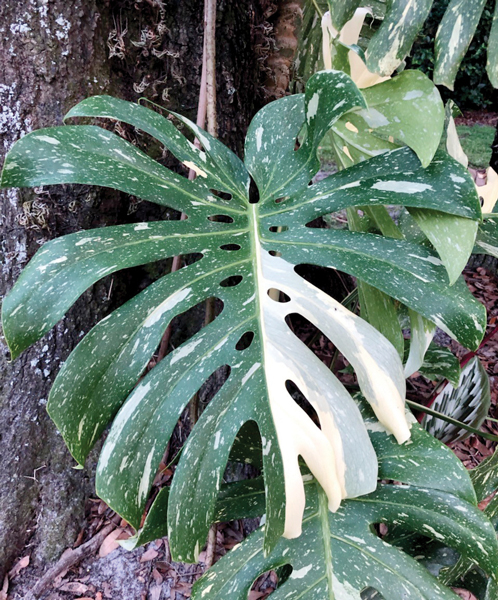12/1/2019
But I Want It … AND I Want It Now!
Austin Bryant

The foliage buyer saunters through a plant industry trade show, browsing a wide array of foliage plants that feature unique colors, textures and variegations. Carefully scanning over the mass carpet of foliage, the eyes narrow in on the Monstera Deliciosa Split Leaf Philo, the hottest plant on EARTH for retail and online foliage sales.
Pinterest and Etsy have made this plant immortal. Any self-respecting plant collector must have a specimen, if not for the uncanny beauty of the plant, but also the rich history of it in our industry. As a long-time foliage grower, I can’t tell you how many thousands of these pots moved through our facility in the late ’80s. It was a staple of the interiorscape industry, whose importance and popularity was equal to that of an Aglaonema or Spathiphyllum.
Pictured: A variegated split leaf monstera. Photo courtesy of Ty Strode at Agri-Starts, Apopka, Florida.
However, moving forward in varietal types and selection, many foliage salespeople would say that a complete foliage plant series must include a variegated and chartreuse variety. Why can’t wholesale growers produce a variegated split leaf? I think the most frustrating part of the “no availability” situation is the fact that there are so many examples of the variegated spit leaf splashed all over the Internet.
The point of this article is to provide some general information on why there isn’t a variegated monstera on the commercial market. We’re going back to school to relearn some scientific terms and plant traits. Warning! There might be some statements that use the words “always,” which in the world of science will always get you in trouble. I know there are exceptions to most things, so for the more technical readers, don’t get bogged down in the details.
So, to begin, let’s refresh what a “chimera” is and why it’s an unruly and formidable adversary in commercial foliage propagation ...
A chimera is a plant that has multiple sets of genetics simultaneously existing in one plant. Each chimera has groups of cells with different genes. These cells are co-existing in the same area of the plant and can exhibit different physical traits. This can most commonly be seen, but is not limited, to leaf and stem variegation. The easiest way to spot a “sectoral chimera” in the foliage world is through the non-symmetrical variegation pattern in the leaf. The variegation might only appear on one side of the leaf or stem.
So why is this important? Commercial propagation of many interior foliage plants is done through tissue culture. Most all tissue culture happens by taking “single” cells and producing new in-vitro plantlets through somatic embryogenesis. If we’re expanding cell propagation from “single” cells we lose the multi-cell genetic situations that caused the chimera in the first place.
Almost 100% of chimera plants reproduced in tissue culture lose the variegation and are just beautiful green plantlets. This happens all the time in our foliage industry where growers will find a plant that carries a different color trait in the greenhouse, and when put into tissue culture, the desired variegation or color is lost.
Another super popular example of chimera in the foliage industry are certain varieties of sansevieria. If a “leaf” cutting is taken from a chimera type of sansevieria and propagated, the resulting plantlet produced will be the original non-variegated parent plant. To get the paired multi-cell arrangement that’s needed to express the remarkable contrasting leaf color variegation, the cutting must be taken all the way back within the rhizome. When a new plantlet advantageously suckers up from the rhizome, it brings with it the paired multi-cell genetic situation that’s arranged together correctly to replicate the color pattern of the parent plant. There are some non-chimera sansevierias that can be done by leaf cutting. These are what I consider original species such as Zeylanica, Parva, Robusta, Silver Queen and others.
So where does this leave us in getting a variegated monstera for the commercial market? Just like the variegated rhapis palm, the propagation can only be done through division or sometimes cutting, which is extraordinarily slow. I’m sure there are breeders diligently working at producing a true, genetically variegated monstera, one that can be propagated via tissue culture. However, this is a fickle market fueled by super high demand and extremely low supply. Only time would tell if a non-chimera variegated monstera would become a staple itself. The mysterious charm of this plant may be lost when commercially reproduced in higher numbers to which everyone would have unlimited access. GT
Austin Bryant is in Sales for Heart of Florida Greenhouses, Inc. in Zolfo Springs, Florida.